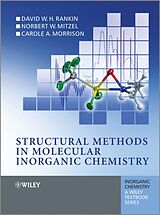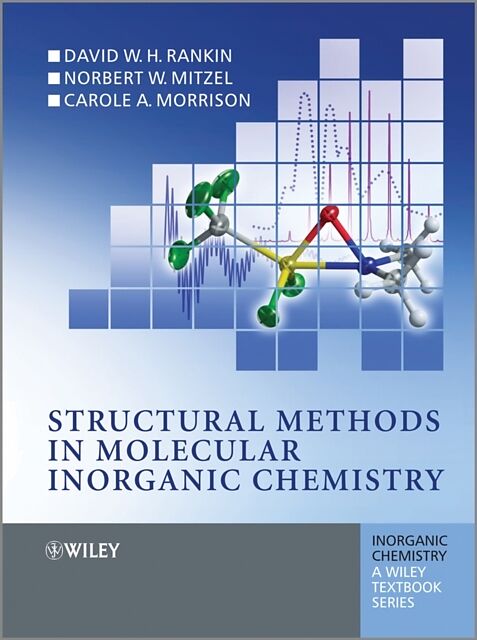Structural Methods in Molecular Inorganic Chemistry
Einband:
Kartonierter Einband
EAN:
9780470972786
Untertitel:
Inorganic Chemistry: A Textbook Series
Genre:
Chemie
Autor:
D. W. H. (University of Edinburgh, Scotland) Rankin, Norbert (Bielefeld University, Germany) Mitzel, Carole (University of Edinburgh, Scotland) Morrison
Herausgeber:
John Wiley & Sons Inc
Auflage:
1. Auflage
Anzahl Seiten:
512
Erscheinungsdatum:
22.02.2013
ISBN:
978-0-470-97278-6
Klappentext Determining the structure of molecules is a fundamental skill that all chemists must learn. Structural Methods in Molecular Inorganic Chemistry is designed to help readers interpret experimental data, understand the material published in modern journals of inorganic chemistry, and make decisions about what techniques will be the most useful in solving particular structural problems.Following a general introduction to the tools and concepts in structural chemistry, the following topics are covered in detail:* computational chemistry* nuclear magnetic resonance spectroscopy* electron paramagnetic resonance spectroscopy* Mössbauer spectroscopy* rotational spectra and rotational structure* vibrational spectroscopy* electronic characterization techniques* diffraction methods* mass spectrometryThe final chapter presents a series of case histories, illustrating how chemists have applied a broad range of structural techniques to interpret and understand chemical systems. Throughout the textbook a strong connection is made between theoretical topics and the real world of practicing chemists. Each chapter concludes with problems and discussion questions, and a supporting website contains additional advanced material.Structural Methods in Molecular Inorganic Chemistry is an extensive update and sequel to the successful textbook Structural Methods in organic Chemistry by Ebsworth, Rankin and Cradock. It is essential reading for all advanced students of chemistry, and a handy reference source for the professional chemist. Zusammenfassung Determining the structure of molecules is a fundamental skill that all chemists must learn. Structural Methods in Molecular Inorganic Chemistry is designed to help readers interpret experimental data, understand the material published in modern journals of inorganic chemistry, and make decisions about what techniques will be the most useful in solving particular structural problems.Following a general introduction to the tools and concepts in structural chemistry, the following topics are covered in detail:* computational chemistry* nuclear magnetic resonance spectroscopy* electron paramagnetic resonance spectroscopy* Mössbauer spectroscopy* rotational spectra and rotational structure* vibrational spectroscopy* electronic characterization techniques* diffraction methods* mass spectrometryThe final chapter presents a series of case histories, illustrating how chemists have applied a broad range of structural techniques to interpret and understand chemical systems.Throughout the textbook a strong connection is made between theoretical topics and the real world of practicing chemists. Each chapter concludes with problems and discussion questions, and a supporting website contains additional advanced material.Structural Methods in Molecular Inorganic Chemistry is an extensive update and sequel to the successful textbook Structural Methods in Inorganic Chemistry by Ebsworth, Rankin and Cradock. It is essential reading for all advanced students of chemistry, and a handy reference source for the professional chemist. Inhaltsverzeichnis Preface xiiiCompanionWebsite xvAcknowledgements xviiBiographies xix1. Determining Structures - How and Why 11.1 Structural chemistry - where did it come from? 11.2 Asking questions about structure 41.3 Answering questions about structure 51.4 Plan of the book 71.5 Supplementary information 82. Tools and Concepts 92.1 Introduction 92.2 How structural chemistry techniques work 102.3 Symmetry 112.4 Electron density 212.5 Potential-energy surfaces 212.6 Timescales 242.7 Structural definitions 262.8 Sample preparation 272.9 Quantitative measurements 302.10 Instrumentation 322.11 Data analysis 363. Theoretical Methods 453.1 Introduction 453.2 Approximating the multi-electron Schrodinger equation 463.3 Exploring the potential-energy surface 523.4 Extending the co...
Inhalt
Preface xiii CompanionWebsite xv Acknowledgements xvii Biographies xix 1. Determining Structures - How and Why 1 1.1 Structural chemistry - where did it come from? 1 1.2 Asking questions about structure 4 1.3 Answering questions about structure 5 1.4 Plan of the book 7 1.5 Supplementary information 8 2. Tools and Concepts 9 2.1 Introduction 9 2.2 How structural chemistry techniques work 10 2.3 Symmetry 11 2.4 Electron density 21 2.5 Potential-energy surfaces 21 2.6 Timescales 24 2.7 Structural definitions 26 2.8 Sample preparation 27 2.9 Quantitative measurements 30 2.10 Instrumentation 32 2.11 Data analysis 36 3. Theoretical Methods 45 3.1 Introduction 45 3.2 Approximating the multi-electron Schrodinger equation 46 3.3 Exploring the potential-energy surface 52 3.4 Extending the computational model to the solid state 56 3.5 Calculating thermodynamic properties 61 3.6 Calculating properties of chemical bonding 63 3.7 Comparing theory with experiment: geometry 65 3.8 Comparing theory with experiment: molecular properties 68 3.9 Combining theory and experiment 74 4. Nuclear Magnetic Resonance Spectroscopy 79 4.1 Introduction 79 4.2 The nuclear magnetic resonance phenomenon 79 4.3 Experimental set-up 83 4.4 The pulse technique 86 4.5 Information from chemical shifts 92 4.6 Information from NMR signal intensities. 100 4.7 Simple splitting patterns due to coupling between nuclear spins 101 4.8 Information from coupling constants 112 4.9 Not-so-simple spectra 116 4.10 The multi-nuclear approach 120 4.11 Multiple resonance 121 4.12 Multi-pulse methods 126 4.13 Two-dimensional NMR spectroscopy 129 4.14 Gases 140 4.15 Liquid crystals 140 4.16 Solids 141 4.17 Monitoring dynamic phenomena and reactions 147 4.18 Paramagnetic compounds 154 5. Electron Paramagnetic Resonance Spectroscopy 169 5.1 The electron paramagnetic resonance experiment 169 5.2 Hyperfine coupling in isotropic systems 171 5.3 Anisotropic systems 175 5.4 Transition-metal complexes 179 5.5 Multiple resonance 182 6. Mossbauer Spectroscopy 189 6.1 Introduction 189 6.2 The Mossbauer effect 189 6.3 Experimental arrangements 192 6.4 Information from Mossbauer spectroscopy 194 6.5 Compound identification 204 6.6 Temperature- and time-dependent effects 208 6.7 Common difficulties encountered in Mossbauer spectroscopy 212 6.8 Further possibilities in Mossbauer spectroscopy 213 7. Rotational Spectra and Rotational Structure 219 7.1 Introduction 219 7.2 The rotation of molecules 219 7.3 Rotational selection rules 224 7.4 Instrumentation 228 7.5 Using the information in a spectrum 229 7.6 Using rotation constants to define molecular structures 232 8. Vibrational Spectroscopy 237 8.1 Introduction 237 8.2 The physical basis; molecular vibrations 237 8.3 Observing molecular vibrations 239 8.4 Effects of phase on spectra 245 8.5 Vibrational spectra and symmetry 248 8.6 Assignment of bands to vibrations 254 8.7 Complete empirical assignment of vibrational spectra 262 8.8 Information from vibrational spectra 263 8.9 Normal coordinate analysis 272 9. Electronic Characterization Techniques 277 9.1 Introduction 277 9.2 Electron energy levels in molecules 278 9.3 Symmetry and molecular orbitals 279 9.4 Photoelectron spectroscopy 281 9.5 Valence excitation spectroscopy 286 9.6 Electronic energy levels and transitions in transition-metal complexes 289 9.7 Circular dichroism 298 10. Diffraction Methods 303 10.1 Introduction 303 10.2 Diffraction of electrons, neutrons and X-rays 304 10.3 Diffraction by gases 308 10.4 Diffraction by liquids 321 10.5 Diffraction by single crystals; symmetry 323 10.6 Diffraction by single crystals; the theoretical basis 329 10.7 Diffraction by single crystals; the experiment. 333 10.8 Diffraction by single crystals; interpretation of results 341 10.9 Diffraction by single crystals; electron density determination 349 10.10 Topological features of the electron density 352 10.11 Phase dependence of molecular structures 363 10.12 Diffraction of neutrons by crystals 365 10.13 Diffraction by powders 368 10.14 High-pressure crystallography 368 10.15 Extende…

Leider konnten wir für diesen Artikel keine Preise ermitteln ...
billigbuch.ch sucht jetzt für Sie die besten Angebote ...
Die aktuellen Verkaufspreise von 6 Onlineshops werden in Realtime abgefragt.
Sie können das gewünschte Produkt anschliessend direkt beim Anbieter Ihrer Wahl bestellen.
Loading...
Die aktuellen Verkaufspreise von 6 Onlineshops werden in Realtime abgefragt.
Sie können das gewünschte Produkt anschliessend direkt beim Anbieter Ihrer Wahl bestellen.
| # | Onlineshop | Preis CHF | Versand CHF | Total CHF | ||
|---|---|---|---|---|---|---|
| 1 | Seller | 0.00 | 0.00 | 0.00 |
